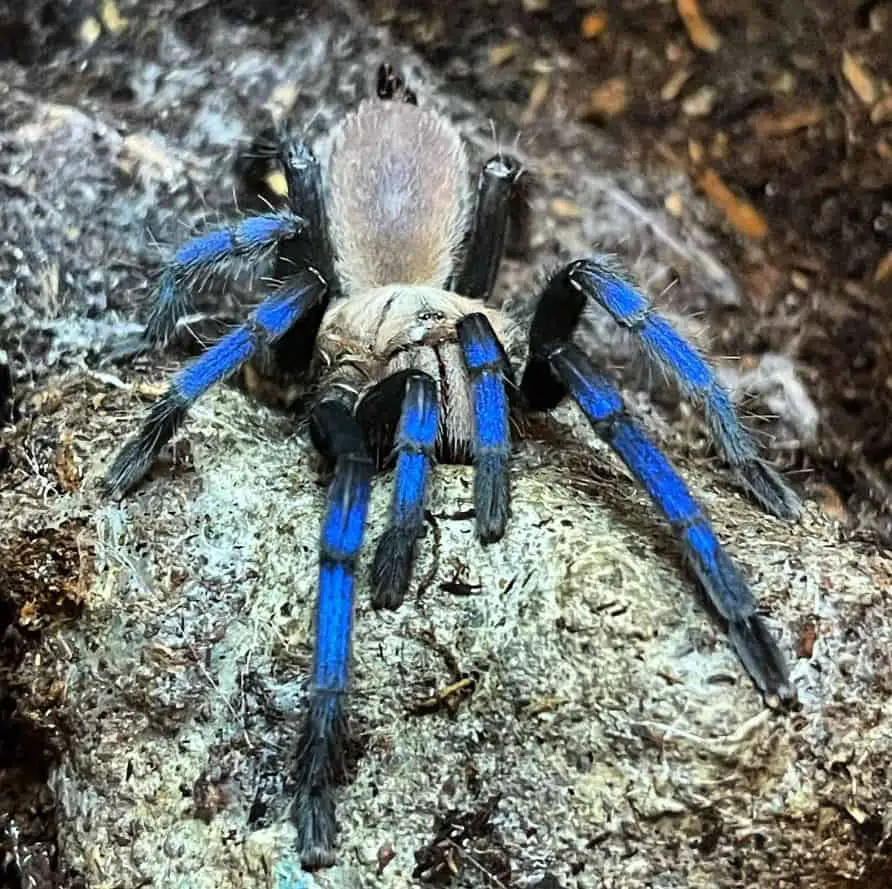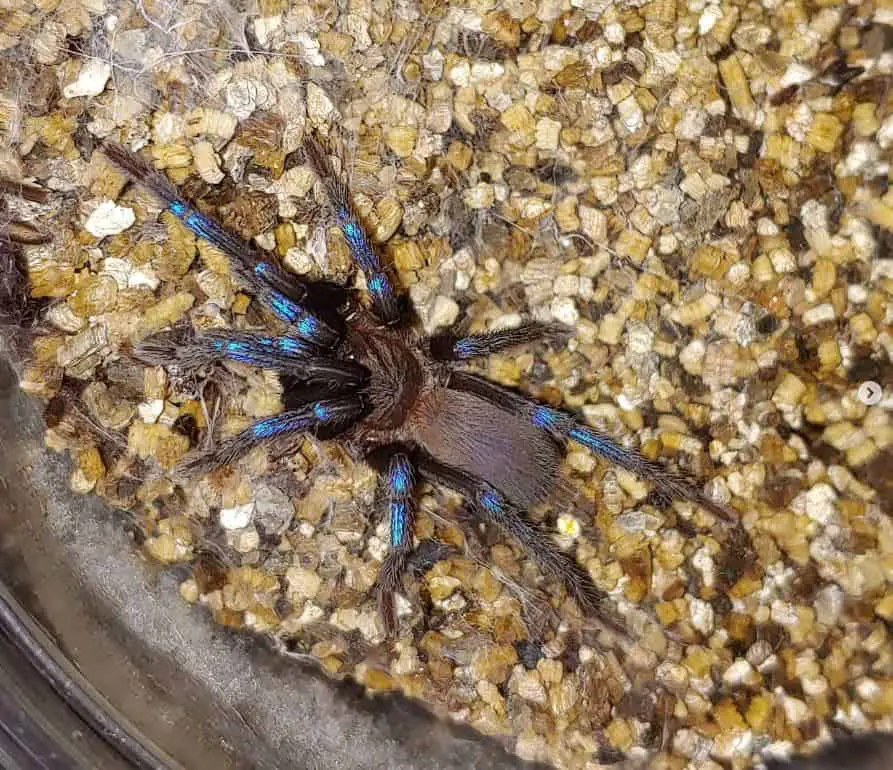The Bornean Neon Blue Leg Tarantula, also known as the Birupes simoroxigorum, is a new addition to the tarantula hobby. It was first discovered as recently as 2019! The introduction of this species is surrounded by quite a bit of controversy. Some consider it the most beautiful spider in the world and would love to have one in their collection. However, its extraction occurred without the permission of its home country. In fact, taking a specimen from the natural habitat is not allowed at all.
However, since some specimens are already removed from the wild and are being bred in captivity, it is possible to get your hands on one that’s captive bred and thus does not put further strain on the wild specimens.
Since this is such a new species it’s too early to provide specific information in some areas of care about this species; the community hasn’t worked with it for long. However, knowing its subspecies and similar spiders, and with the information we’ve gathered so far, it’s possible to provide safe care tips for enthusiasts looking to get one.

Neon Blue Leg Tarantula Care Sheet
| Species Name | Birupes simoroxigorum |
| Family Name | Theraphosidae |
| Common Name | Bornean Neon Blue Leg Tarantula |
| Category | Old World |
| Type | Terrestrial Burrower |
| Native Location | Borneo, Malaysia |
| Leg Span | 5 inches (12cm) |
| Growth Speed | Fast |
| Urticating Hairs | No |
| Social | Solitary |
| Diet | Insects: crickets, roaches |
| Temperature | 80 to 85 degrees Fahrenheit |
| Humidity | 75 to 85% |
| Life Expectancy | Unknown |
| Recommended Experience Level | Intermediate |
| Minimum tank size | 3 to 5 gallons, width more important than height |
Neon Blue Leg Tarantula overview
The Birupes simoroxigorum is commonly known as the Bornean Neon Blue Leg Tarantula but also goes by the name of Sarawak Blue Tarantula. They’re a terrestrial species and obligate burrowers, so they’ll spend plenty of time inside their burrows.
However, when they go out, the bright blue color on their legs makes the wait worthwhile.
Since they’re an Old World species they don’t have urticating hairs, but they do have more potent venom than most New World species.
Appearance & variants

As her name implies, the Neon Blue Leg Tarantula has such bright blue colors on her legs that it looks like she’s carrying eight blue neon signs beside her body. Her aesthetic appeal lies in her bright blue legs and cream brown body.
This species is not a particularly large spider. As is standard with tarantulas, males are slightly smaller than females. In addition, males do not seem to have the electric blue legs that females are so well known for.
You’ll also notice that sometimes the blue color is lighter; this happens mostly when it’s about to molt. The blue color will return right after molting as quickly as ever.
Price
The Neon Blue Leg Tarantula is currently the new kid on the block for hobbyists. This, the shortage of breeding, and the high demand due to its attractive colors drive the price up.
Blue Leg Tarantula slings will cost between $90 and $180 depending on where you find them. Young adults will vary their costs depending on their sex, whereas males can be found for around $360, and females go up to a whopping $1,400.
Wherever you buy it, make sure you get it from a reputable vendor that sells spiders bred in captivity to avoid supporting the poacher’s business. I can’t stress enough how important this is. We all enjoy these spiders and we don’t want to remove them from their natural habitat.
Behavior and Temperament
The Bornean Neon Blue Leg Tarantula is described as a peaceful tarantula. She won’t jump or burrow away at first glance of you approaching, so it’s possible to open the tank and stare at her.
She’ll often take her time before jumping over her prey, so she’s not the most voracious feeder. Once frightened, she’ll move fast to find refuge; and she won’t assume a threat posture until truly cornered, so she’s not very dangerous.
Because of her relatively peaceful demeanor, we don’t have enough information about her venom to know whether it’s strong or weak, but it’s surely not lethal. Nevertheless, since most Old World species have relatively potent venom to make up for their lack of urticating hairs, make sure that you avoid handling them to avoid getting bitten.
Caring for a Bornean Neon Blue Leg Tarantula
Temperature and Humidity
The Bornean Neon Blue Leg Tarantula lives in a tropical rainforest climate. Temperatures lie between 79°F to 84°F at nighttime, and 86°F to 95°F during the day. In captivity, you should keep this spider at around 80°F to 85°F. Humidity is approximately 80% in Borneo, so 75% to 85% will be good enough for your spiders.
Some owners struggle to keep the humidity at adequate levels. Sphagnum moss can be a great tool to help with that. Alternatively, an oversized water bowl can be a great aid to increase the moisture in the air because the increased evaporation will raise the humidity. If those things are still not enough you can occasionally spray their enclosure.
Substrate
Bornean Neon Blue Leg Tarantulas are obligate burrowers, so you should make sure they have enough room to burrow. Three inches of substrate for spiderlings and younglings and five inches for adults at least should be enough.
Even though they’re small spiders, they enjoy deep burrows. Peat moss is excellent for spiderlings, and mixtures with coconut fibers will work for adults. Make sure to dig a small burrow for spiderlings to make it easier to hide.
Tank
Even though they will spend the majority of their time in their self-made burrows, which they line with their webs, the Sarawak Blue Tarantula enjoys having plenty of places to hide.
Having plenty of decoration, artificial plants, leaves, and bark, will not only embellish the tank but also make it more comfortable for the tarantula.
As for size, a tank of three to five gallons should be enough for adults, one quart for juveniles, and around sixteen ounces for slings; since this is a terrestrial species, always make sure that it’s wider than it is tall.
Watering
Bornean Neon Blue Leg Tarantulas are often steady when the tank is opened, so having a water dish inside the tank and constantly refilling it isn’t tricky for experienced hobbyists.
You should also keep the substrate moist, and it’s best when the deeper layers are moist and cool while the cover is drier.
The BNBLTs enjoy retreating to a deep, cool, moist burrow, so this is the effect you’ll want on the substrate. You’ll want to drip water down the tank wall at least once every week to get this effect.
Social
Some tarantula species, such as the Socotra Blue Baboon, are capable of living communally. However, most species, including the Neon Blue Leg, should be housed solitarily. They can be quite territorial and typically only meet when it’s time to breed.
Diet and feeding
The Bornean Neon Blue Leg Tarantula is fed similarly to other tarantulas. Their primary source of food should be a variety of different insects. However, these spiders tend to be skittish and bad eaters, so you may want to wound or kill their prey if you see them having trouble with them.
Slings should eat either a small cricket or a flightless fruit fly twice a week, and juveniles should eat a small roach weekly.
Hobbyists with adult specimens claim to feed them a large cricket or medium cockroach every seven to ten days.
However, to be sure, pay attention to their abdomens to know if they need more or less food. If the abdomen is getting bigger, increase the amount of food or frequency, and do the opposite if you see the abdomen grow bigger and rounder.
When it comes to drinking, tarantulas only drink water. When they’re adults they can drink from a bowl. Slings and juveniles that are not yet large enough to drink from a bowl can drink the drops that you drip down the side of the enclosure.
Breeding the Bornean Neon Blue Leg Tarantula
There’s no consensus around breeding techniques for the Bornean Neon Blue Leg Tarantula. It’s still unexplored territory, as there are not enough hobbyists breeding these beautiful spiders. If you’re going to attempt breeding them, make sure they’re properly fed, the temperature and humidity are comfortable for them, and don’t leave them alone during the interaction to guard the male against any harm.
Also, breeding is something that’s best left to experts. Tarantulas can have hundreds of slings at a time which will grow quite quickly. If you don’t know what you’re doing you could end up with hundreds of spiders that can be difficult to find homes for.
Final words: Is the Neon Blue Leg the right Tarantula for you?
The recent popularity of the Bornean Neon Blue Leg Tarantula is well-deserved. They’re a beautiful Old World species whose intriguing colors make for a stunning exhibition spider. However, since they’re a very new addition to the spider family, not all too much is known about them, which makes it more difficult to care for them.
If you do end up deciding that you want to add them to your collection, make sure that you buy from a reputable breeder and that the spider you buy is bred in captivity!
We hope this guide gave you the information to decide if a BNBLT is the best fit for you.
- How Long Do American Eskimo Dogs Live? Important Factors and Care Tips - September 29, 2023
- Do American Bulldogs Need Grooming? Essential Tips and Care Guidelines - September 29, 2023
- Do Bengal Cats Enjoy Playing? Essential Tips for Keeping Them Active - September 29, 2023